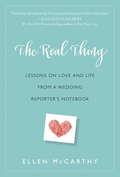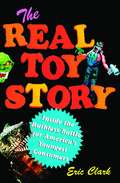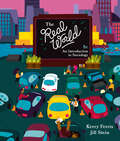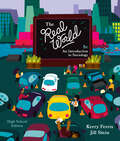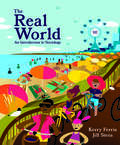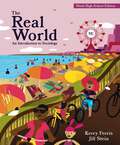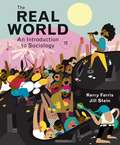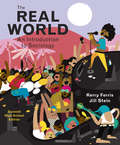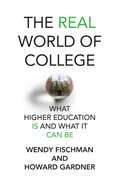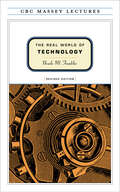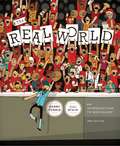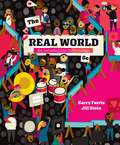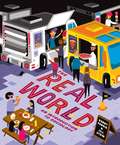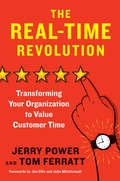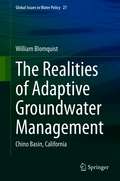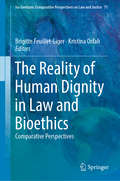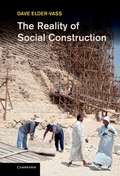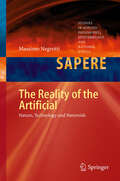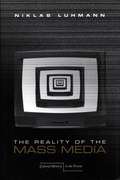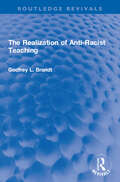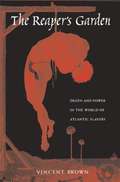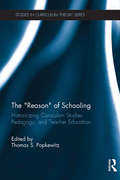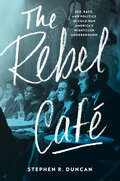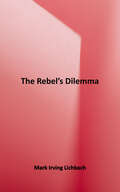- Table View
- List View
The Real Thing
by Ellen MccarthyFrom a Washington Post weddings reporter who's covered more than two hundred walks down the aisle comes a warm, witty, and wise book about relationships--the mystery, the science, and the secrets of how we find love and make it last. Ellen McCarthy has explored the complete journey of our timeless quest for "The One," the Soul Mate, the Real Thing. This indispensable collection of insights--on dating, commitment, breakups, weddings, and marriage--gives us a window into enduring romance: * Go Online Already--"It's a major time suck and a black hole of rejection and ambiguity and lies. But you know what? It also works." * Keep It Confidential--"If you have to get something off your chest, pick someone whose wisdom you really trust, and who isn't likely to spread the gossip to all your mutual acquaintances." * Be Nice--"Brewing the morning coffee, touching the small of your partner's back, filling their car with gas. These things add up to more relationship satisfaction than a fancy dinner on Valentine's Day ever could." The Real Thing features many more nuggets of wisdom, valuable information from the latest studies on commitment, candid testimonials from a variety of couples, and the personal story of McCarthy's own search for "the keeper"--which begins, ironically, with a breakup the very same day she started as the Post's full-time weddings reporter. Whether you're looking for love or looking to strengthen your relationship, this book is a wonderful and clear-eyed map to the human heart.Praise for The Real Thing "A wise and compassionate look at how we love, along with some gentle suggestions for how we could get a little better at it . . . McCarthy has done something rare: She has written an optimistic book about love that is clear-eyed and unsentimental."--The Washington Post"What a charming and captivating book this is! We never stop learning about love, and so many great lessons are within these pages."--Elizabeth Gilbert, author of Eat, Pray, Love "My readers often say to me, 'If we lived next door to each other, we'd be best friends.' That is precisely what I wanted to say to smart, funny, self-effacing Ellen McCarthy after I finished reading The Real Thing. I loved every lesson laid out in a book that wouldn't dare to call itself a field guide to marriage but amounts to as much on every page. This is a deeply useful little book."--Kelly Corrigan, author of Glitter and Glue "Upbeat and sweet . . . This rich collection of stories charms and edifies, is filled with quotes from couples as well as experts in the field, and serves as not just stories to sigh over but lessons to apply."--Booklist (starred review) "A fun read full of wonderful stories . . . McCarthy delivers a welcome combination of cynicism and poignancy in this account, which reads with the ease and accessibility of a self-help book."--Library Journal "A comforting, realistic, and endearing portrait of modern relationships . . . This book will not only charm those in decades-old marriages, but also inspire those afraid love will never arrive for them."--Publishers Weekly "Straight-talking . . . dating advice for adults of all ages."--Kirkus ReviewsFrom the Hardcover edition.
The Real Toy Story
by Eric ClarkThe American toy business is massive, world dominating, cutthroat, exciting, and increasingly willing to sacrifice our kids in its frantic rush for profit. And yet, for all its rapaciousness, the industry is in the business of delighting and fascinating our children. Toys are one of the most emotive subjects in the world. We all remember our own toys; we care desperately about those we choose for our kids, knowing these objects help shape children's lives. They are also a constantly newsworthy item: every Christmas, which toys are hot -- and the scramble by parents to grab them before the stores are empty -- is front-page and TV bulletin news. The Real Toy Story tells the tales of these toys and of the vast, world-dominating $22 billion American industry that creates them. The rewards for success are enormous: a top toy can earn billions -- H. Ty Warner shot into Forbes's World's Richest People list with his creation of Beanie Babies. The price of failure is just as huge -- the battlefield is littered with the corpses of once-successful toy companies whose multimillion-dollar gambles did not pay off. It is a world of contrasts. The Real Toy Story looks at both sides: at Slinky, Elmo, Barbie, Transformers, and their creators, but also at the dark side of an industry that leads the way in cold-blooded marketing targeted at children. Parents will want to learn about how this seemingly benign industry exploits, sometimes surreptitiously, the many new media: cable television, the internet, CD-ROMs, sometimes even invading the playgrounds to peddle their wares to unsuspecting young people. Perhaps more disturbingly, this hard-hitting book examines the vast gap between the cuddly image of toys and how almost all toys destined for America are actually produced in China under sweatshop conditions. Today the toy industry is in the midst of rapid change. Tapping into the concern millions of adults have about the toys they choose for the children in their lives, this riveting exposé is essential reading for everyone who cares about kids.
The Real World (Eighth Edition)
by Kerry Ferris Jill SteinThe most relevant textbook for today’s students Instructors adopt—and stick with—The Real World because students love it. And students love it because it was written for them. In every chapter, Ferris and Stein use examples from everyday life, the media, and pop culture to get students thinking sociologically and to show the relevance of sociology to their relationships, jobs, and the future of society. Innovative and assignable Data Workshops in every chapter and online give students a chance to apply theoretical concepts to their own lives and actually do sociology. Expansive coverage of the Covid-19 pandemic throughout the Eighth Edition package highlights how the pandemic has affected all aspects of social life, from how we work and learn to the way we organize our family lives. This purchase offers access to the digital ebook only.
The Real World (Eighth High School Edition)
by Kerry Ferris Jill SteinThe most relevant textbook for today’s students Teachers select The Real World because students love it. And students love it because it was written for them. In every chapter, Ferris and Stein use examples from everyday life, the media, and pop culture to get students thinking sociologically and to show the relevance of sociology to their relationships and future careers. Innovative and assignable Data Workshops in every chapter and online give students a chance to apply theoretical concepts to their own lives and actually do sociology. Aligned to the American Sociological Association (ASA)’s National Standards for High School Sociology and featuring a robust support package, The Real World sets both students and instructors up for success. This purchase offers access to the digital ebook only.
The Real World (Ninth Edition): An Introduction To Sociology
by Kerry Ferris Jill SteinThe most relevant textbook for today’s students The Real World is the best-selling book for the introductory course because students love it. In every chapter, Ferris and Stein use examples from everyday life, the media, and pop culture to get students thinking sociologically and to show the relevance of sociology to their relationships, jobs, and the future of society. Innovative and assignable Data Workshops give students a chance to apply theoretical concepts to their own lives and get hands-on experience with the tools of social science. New Theory in Everyday Life interactives in the Norton Illumine Ebook, along with Check Your Understanding questions with answer-specific feedback and rich multimodal tools such as short video clips and Dynamic Data Figures, support students as they develop their sociological imaginations. This purchase offers access to the digital ebook only.
The Real World (Ninth High School Edition): An Introduction To Sociology
by Kerry Ferris Jill SteinThe most relevant textbook for today’s students Teachers select The Real World because students love it. Kerry Ferris and Jill Stein set out to write a book that was sorely needed for sociology courses: one that was written for student readers. Now in its Ninth Edition, The Real World been used by over 7,500 high school students. In every chapter, Ferris and Stein use examples from everyday life, the media, and pop culture to get students thinking sociologically and to show the relevance of sociology to their relationships, jobs, and the future of society. Innovative and assignable Data Workshops give students a chance to apply theoretical concepts to their own lives and get hands-on experience with the tools of social science. The new Norton Illumine Ebook features interactives, videos, and concept check questions to support students as they develop their sociological imaginations. This purchase offers access to the digital ebook only.
The Real World (Seventh Edition)
by Kerry Ferris Jill SteinThe most relevant textbook for today’s students Students love The Real World because it was written for them. In every chapter, Ferris and Stein use examples from everyday life and pop culture to get students thinking sociologically and to show the relevance of sociology to their relationships, jobs, and the future of society. Innovative Data Workshops in every chapter give students a chance to apply theoretical concepts to their own lives and actually do sociology. With low-cost formats, The Real World sets both students and instructors up for success. This purchase offers access to the digital ebook only.
The Real World (Seventh High School Edition)
by Kerry Ferris Jill SteinThe most relevant textbook for today’s high school students Students love The Real World because it was written for them. In every chapter, Ferris and Stein use examples from everyday life and pop culture to get students thinking sociologically and to show the relevance of sociology to their relationships, jobs, and the future of society. Innovative Data Workshops in every chapter give students a chance to apply theoretical concepts to their own lives and actually do sociology. With low-cost formats, The Real World sets both students and instructors up for success. This purchase offers access to the digital ebook only.
The Real World of College: What Higher Education Is and What It Can Be
by Howard Gardner Wendy FischmanWhy higher education in the United States has lost its way, and how universities and colleges can focus sharply on their core mission.For The Real World of College, Wendy Fischman and Howard Gardner analyzed in-depth interviews with more than 2,000 students, alumni, faculty, administrators, parents, trustees, and others, which were conducted at ten institutions ranging from highly selective liberal arts colleges to less-selective state schools. What they found challenged characterizations in the media: students are not preoccupied by political correctness, free speech, or even the cost of college. They are most concerned about their GPA and their resumes; they see jobs and earning potential as more important than learning. Many say they face mental health challenges, fear that they don&’t belong, and feel a deep sense of alienation. Given this daily reality for students, has higher education lost its way? Fischman and Gardner contend that US universities and colleges must focus sharply on their core educational mission. Fischman and Gardner, both recognized authorities on education and learning, argue that higher education in the United States has lost sight of its principal reason for existing: not vocational training, not the provision of campus amenities, but to increase what Fischman and Gardner call &“higher education capital&”—to help students think well and broadly, express themselves clearly, explore new areas, and be open to possible transformations. Fischman and Gardner offer cogent recommendations for how every college can become a community of learners who are open to change as thinkers, citizens, and human beings.
The Real World of Technology (The CBC Massey Lectures)
by Ursula FranklinIn this expanded edition of her bestselling 1989 CBC Massey Lectures, renowned scientist and humanitarian Ursula M. Franklin examines the impact of technology upon our lives and addresses the extraordinary changes since The Real World of Technology was first published. In four new chapters, Franklin tackles contentious issues, such as the dilution of privacy and intellectual property rights, the impact of the current technology on government and governance, the shift from consumer capitalism to investment capitalism, and the influence of the Internet upon the craft of writing.
The Real World: An Introduction to Sociology
by Kerry Ferris Jill SteinThe Real World succeeds in classrooms, because it focuses on the perspective that students care about mostly their own. In every chapter, the authors use activities, examples from everyday life, and popular culture to draw students into thinking sociologically and to make abstract concepts more concrete.
The Real World: An Introduction to Sociology
by Kerry Ferris Jill SteinThe Real World succeeds in classrooms because it focuses on the perspective that students know best―their own. In every chapter, Ferris and Stein use examples from everyday life and pop culture to draw students into thinking sociologically and to show the relevance of sociology to their relationships, jobs, and future goals. Data Workshops in every chapter give students a chance to apply theoretical concepts to their personal lives and actually do sociology.
The Real World: An Introduction to Sociology (Fifth Edition)
by Kerry Ferris Jill SteinThe Real World succeeds in classrooms because it focuses on the perspective that students care about most-their own. In every chapter, authors Kerry Ferris and Jill Stein use examples from everyday life and popular culture to draw students into thinking sociologically and to show the relevance of sociology to our relationships, our jobs, and our future goals.
The Real-Time Revolution: Transforming Your Organization to Value Customer Time
by Jerry Power Thomas FerrattTime has become a precious commodity, so business leaders who can save their customers' time more effectively than competitors do will win their loyalty. This book shows how it's done. Business survival requires valuing what customers value—and in our overworked and distraction-rich era, customers value their time above all else. Real-time companies beat their rivals by being faster and more responsive in meeting customer needs. To become a real-time company, as top scholars Jerry Power and Tom Ferratt explain, you need a real-time monitoring and response system. They offer detailed advice on how to put procedures in place that will collect data on how well products or services are saving customer time; identify strengths, weaknesses, threats, and opportunities; and specify innovations needed to save even more customer time. Where should leaders look to innovate? Powers and Ferratt say to search every step in the life of a product or service, from development to production to usage. And for each step, they identify four possible levers for innovation: the design of the products or services themselves, the process used to produce them, the data that can be gathered on their use, and the people who make or provide the product or service. The book features dozens of examples of companies that are getting it right and the innovations they used to help their customers save time, all while helping themselves to a hefty slice of market share. This is a comprehensive, authoritative guide to thriving in a revolution that is sweeping every industry and sector.
The Realities of Adaptive Groundwater Management: Chino Basin, California (Global Issues in Water Policy #27)
by William BlomquistThis book has three primary objectives. The first objective is to provide scholars with a more realistic view of adaptive management, without arguing against adaptive management. Adaptive management is necessary as well as desirable, but it is not easy, and demonstrating that through the Chino Basin experience is an important goal. The second objective is to provide practitioners with encouraging yet cautionary lessons about the challenges and benefits of an adaptive approach – in similar fashion as the first objective, the goal here is to endorse the adaptive approach but in a clear-eyed manner that clarifies how hard it is and how much it requires. A third objective is to show all audiences that resource governance systems can fail, change, and succeed. There is no such thing as an ideal institutional design that is guaranteed to work; rather, making institutional arrangements work entails learning and adjustment when they begin to show problems as they inevitably will.
The Reality of Human Dignity in Law and Bioethics: Comparative Perspectives (Ius Gentium: Comparative Perspectives on Law and Justice #71)
by Brigitte Feuillet-Liger Kristina OrfaliAdopting an interdisciplinary perspective, this volume explores the reality of the principle of human dignity – a core value which is increasingly invoked in our societies and legal systems. This book provides a systematic overview of the legal and philosophical concept in sixteen countries representing different cultural and religious contexts and examines in particular its use in a developing case law (including of the European Court of Human Rights and of the Inter-American Court of Human Rights). Whilst omnipresent in the context of bioethics, this book reveals its wider use in healthcare more generally, treatment of prisoners, education, employment, and matters of life and death in many countries. In this unique comparative work, contributing authors share a multidisciplinary analysis of the use (and potential misuse) of the principle of dignity in Europe, Africa, South and North America and Asia. By revealing the ambivalence of human dignity in a wide range of cultures and contexts and through the evolving reality of case law, this book is a valuable resource for students, scholars and professionals working in bioethics, medicine, social sciences and law. Ultimately, it will make all those who invoke the principle of human dignity more aware of its multi-layered character and force us all to reflect on its ability to further social justice within our societies.
The Reality of Social Construction
by Dave Elder-Vass'Social construction' is a central metaphor in contemporary social science, yet it is used and understood in widely divergent and indeed conflicting ways by different thinkers. Most commonly, it is seen as radically opposed to realist social theory. Dave Elder-Vass argues that social scientists should be both realists and social constructionists and that coherent versions of these ways of thinking are entirely compatible with each other. This book seeks to transform prevailing understandings of the relationship between realism and constructionism. It offers a thorough ontological analysis of the phenomena of language, discourse, culture and knowledge, and shows how this justifies a realist version of social constructionism. In doing so, however, it also develops an analysis of these phenomena that is significant in its own right.
The Reality of the Artificial
by Massimo NegrottiThe human ambition to reproduce and improve natural objects and processes has a long history, and ranges from dreams to actual design, from Icarus's wings to modern robotics and bioengineering. This imperative seems to be linked not only to practical utility but also to our deepest psychology. Nevertheless, reproducing something natural is not an easy enterprise, and the actual replication of a natural object or process by means of some technology is impossible. In this book the author uses the term naturoid to designate any real artifact arising from our attempts to reproduce natural instances. He concentrates on activities that involve the reproduction of something existing in nature, and whose reproduction, through construction strategies which differ from natural ones, we consider to be useful, appealing or interesting. The development of naturoids may be viewed as a distinct class of technological activity, and the concept should be useful for methodological research into establishing the common rules, potentialities and constraints that characterize the human effort to reproduce natural objects. The author shows that a naturoid is always the result of a reduction of the complexity of natural objects, due to an unavoidable multiple selection strategy. Nevertheless, the reproduction process implies that naturoids take on their own new complexity, resulting in a transfiguration of the natural exemplars and their performances, and leading to a true innovation explosion. While the core performances of contemporary naturoids improve, paradoxically the more a naturoid develops the further it moves away from its natural counterpart. Therefore, naturoids will more and more affect our relationships with advanced technologies and with nature, but in ways quite beyond our predictive capabilities. The book will be of interest to design scholars and researchers of technology, cultural studies, anthropology and the sociology of science and technology.
The Reality of the Mass Media (Cultural Memory in the Present)
by Niklas Luhmann Kathleen Cross<p>In The Reality of the Mass Media, Luhmann extends his theory of social systems—applied in his earlier works to the economy, the political system, art, religion, the sciences, and law—to an examination of the role of mass media in the construction of social reality. <p>Luhmann argues that the system of mass media is a set of recursive, self-referential programs of communication, whose functions are not determined by the external values of truthfulness, objectivity, or knowledge, nor by specific social interests or political directives. Rather, he contends that the system of mass media is regulated by the internal code information/noninformation, which enables the system to select its information (news) from its own environment and to communicate this information in accordance with its own reflexive criteria. <p>Despite its self-referential quality, Luhmann describes the mass media as one of the key cognitive systems of modern society, by means of which society constructs the illusion of its own reality. The reality of mass media, he argues, allows societies to process information without destabilizing social roles or overburdening social actors. It forms a broad reservoir (memory) of options for the future coordination of action, and it provides parameters for the stabilization of political reproduction of society, as it produces a continuous self-description of the world around which modern society can orient itself. <p>In his discussion of mass media, Luhmann elaborates a theory of communication in which communication is seen not as the act of a particular consciousness, nor the medium of integrative social norms, but merely the technical codes through which systemic operations arrange and perpetuate themselves.</p>
The Realization of Anti-Racist Teaching (Routledge Revivals)
by Godfrey L. BrandtFirst published in 1986, The Realization of Anti-Racist Teaching explores the subject and importance of anti-racist education. The book examines the relationship between the educational debate at the level of academic institutions, professional organisations, and local education authorities within the context of the actual practice of teaching. It also questions how to link anti-racist theories put forward by theorists and activists to the practice of teachers. The Realization of Anti-Racist Teaching is a detailed discussion of the history of racism and of anti-racist teaching and education.
The Reaper's Garden: Death and Power in the World of Atlantic Slavery
by Vincent BrownBasing his study in Jamaica, Vincent Brown investigates what people thought about death in the world of Atlantic slavery. In his story of a world in flux he shows that death was as generative as it was destructive, and that the Grim Reaper became entwined in the social fabric of the island at the centre of the slave trade.
The Reason of Schooling: Historicizing Curriculum Studies, Pedagogy, and Teacher Education (Studies in Curriculum Theory Series)
by Thomas S. PopkewitzProblematizing the "reason" of schooling as historical and political, in this book leading international and interdisciplinary scholars challenge the common sense of schooling and the relation of society, education, and curriculum studies. Examining the limits of contemporary notions of power and schooling, the argument is that the principles that order school subjects, the curriculum, and teaching reforms are historical practices that govern what is thought, acted on, and talked about. Highlighting the dynamics of social exclusion, the normalizing of people through curriculum, and questions of social inclusion, The "Reason" of Schooling underscores the urgency for rethinking curriculum research.
The Rebel Café: Sex, Race, and Politics in Cold War America’s Nightclub Underground
by Stephen R. DuncanSubterranean nightspots in 1950s New York and San Francisco were social, cultural, and political hothouses for left-wing bohemians.The art and antics of rebellious figures in 1950s American nightlife—from the Beat Generation to eccentric jazz musicians and comedians—have long fascinated fans and scholars alike. In The Rebel Café, Stephen R. Duncan flips the frame, focusing on the New York and San Francisco bars, nightclubs, and coffeehouses from which these cultural icons emerged. Duncan shows that the sexy, smoky sites of bohemian Greenwich Village and North Beach offered not just entertainment but doorways to a new sociopolitical consciousness. This book is a collective biography of the places that harbored beatniks, blabbermouths, hipsters, playboys, and partisans who altered the shape of postwar liberal politics and culture. Throughout this period, Duncan argues, nightspots were crucial—albeit informal—institutions of the American democratic public sphere. Amid the Red Scare’s repressive politics, the urban underground of New York and San Francisco acted as both a fallout shelter for left-wingers and a laboratory for social experimentation. Touching on literary figures from Norman Mailer and Amiri Baraka to Susan Sontag as well as performers ranging from Dave Brubeck to Maya Angelou to Lenny Bruce, The Rebel Café profiles hot spots such as the Village Vanguard, the hungry i, the Black Cat Cafe, and the White Horse Tavern. Ultimately, the book provides a deeper view of 1950s America, not simply as the black-and-white precursor to the Technicolor flamboyance of the sixties but as a rich period of artistic expression and identity formation that blended cultural production and politics.
The Rebel Within: Joseph Stiglitz and the World Bank
by Ha-Joon Chang Joseph StiglitzCritique of the role and effectiveness of the World Bank.
The Rebel's Dilemma (Economics, Cognition, And Society Ser.)
by Mark I. LichbachSince the mid-1960s, theorists have elaborated over two dozen different solutions to the collective action problem. During this same period, students of conflict have explored many questions about protest and rebellion. The Rebel's Dilemma examines what happens when one brings the full richness of collective action theories to bear on the many complex problems of collective dissent. The book develops a new typology of solutions to the collective action problem: market, community, contract, and hierarchy. It then uses the typology to explain how the Rebel's Dilemma (i.e., the problem applied to collective dissent) is overcome by rebels. In placing two dozen different sets of solutions into this typology, four themes are developed. First, the Rebel's Dilemma is not all that much of a dilemma. If the collective action problem can be solved in some two dozen ways, it cannot pose an insurmountable hurdle for potential dissidents. Second, both dissidents and regimes know that the Rebel's Dilemma can be overcome. While dissidents try to solve their collective action problem, the regime tries to intensify that problem. This struggle over solutions to the collective action problem is the political struggle between regimes and oppositions. Third, analysts must specify the conditions under which collective action is effective. Finally, the collective action approach makes a major contribution to conflict studies. By dissecting the causes and consequences of solutions to the Rebel's Dilemma, the approach offers a set of implications that are far richer than anything offered by its competitors.
